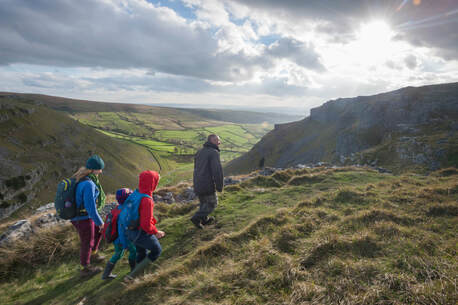 Image by Paul Harris
Image by Paul Harris While I never intended the blogs to follow any specific order, this morning I realised it seems a bit remiss to have not started with something quite important - the Yorkshire Dales National Park. This website looks at all of the Yorkshire Dales, the National Park, Nidderdale Area of Outstanding Natural Beauty and the many small towns and villages around the fringes of the National Park that provide such a good base for visits. At the heart of all this though is the National Park, worth a closer look.
What makes the Yorkshire Dales so special?
Here are just some of the better known features within the whole of the Dales that locals and visitors love so much:
- Unfenced roads across open moorlands with dramatic panoramas across the landscape and into the valleys below, and hay meadows, rich in herbs and wildflowers
- The high winding Buttertubs Pass and heather tops: see the wonderful seasonal colour changes from brown to green, purple & white.
- Caves such as: Gaping Gill System, Kingsdale Master System, Alum Pot, Hull Pot and Show caves: Ingleborough & White Scar Caves, Ingleton, How Stean Gorge, Stump Cross Cavern.
- Stone-built field barns: Field barns and cow houses or laithes are a distinctive feature of the Yorkshire Dales landscape. Barns were used as a combination of cattle housing and fodder storage.
- Spectacular waterfalls, such as Hardraw Force, Aysgarth Falls, Cautley Spout and Thornton Force
- Mysterious ruins and remains of the lead mining and lime industry, particularly just below Coldstones Cut in Nidderdale and the Hoffman Kiln between Langcliffe and Stainforth
- Millstone grit outcrops such as the Three Peaks and sandstone tors like Brimham Rocks
- A sense of tranquillity, enhanced by the natural sounds of wind, water and birdsong and an amazing night sky, with dramatic effects from the moon, stars, and planets
- Sheep, sheep, sheep everywhere!
How was the Yorkshire Dales National Park created?
The story really starts not in Yorkshire but over the border, in the Lake District with a famous poet - Wordsworth. During the early 19th century many romantic writers were inspired by beautiful landscapes and wrote poetry extolling its virtues. Wordsworth was passionate about the Lake District and wrote "a sort of national property, in which every man has a right and interest who has an eye to perceive and a heart to enjoy". The seed of an idea for National Parks was sown.
James Bryce MP started the first campaign for public access to the countryside and introduced the first 'right to roam" bill to parliament in 1884 but it failed. Luckily he and other passionate supporters were incredibly persistent, all believing the beauty and benefits of the countryside should be available to all. The bill was re-introduced every year until 1914, failing each time.
During that time there was a growing appreciation of the countryside and opportunities for physical exercise in the open air, just as industrial towns were growing. Landowners and members of the public clashed, and in 1932 several people were sent to jail for leading a mass trespass on Kinder Scout in the Peak District. Ironically these arrests actually helped as they made more people aware of the fight for a right to roam. Government had been looking at the possible creation of a National Park Authority to decide which areas might become National Parks but no action was taken.
Several groups of people such as the Ramblers' Association and Council for the Preservation for
Rural England lobbied the Government to protect the countryside and widen access. After the war, in 1949 the government finally passed an Act of Parliament to establish National Parks to preserve and enhance their natural beauty and provide recreational opportunities for the public.
The first National Park was created in 1951 in the Peak District and the Yorkshire Dales National Park was established in 1954 in recognition of its "extraordinary natural beauty, diversity of its wildlife habitats, its rich cultural heritage and its fantastic opportunities for outdoor recreation". The story doesn't stop there, as the boundary of the Yorkshire Dales National Park was extended in 2016, to include a small part of Lancashire and parts of Cumbria.
The purposes of the National Park were established in parliament and are: to conserve and enhance the natural beauty, wildlife and cultural heritage of the National Park; and to promote opportunities for the understanding and enjoyment of the special qualities of the area by the public. In doing so they are also required to foster the economic and social well-being of local communities within the National Park.
A few Yorkshire Dales National Park facts
The Yorkshire Dales National Park is now home to around 24,000 human inhabitants and around 600,000 sheep! The area covers around 841 square miles (2,179 square kilometres), and includes about 1700 listed buildings, 200 scheduled ancient monuments, and over 1600 miles of rights of way, including part of the iconic Pennine Way. There are over 5000 miles of dry stone wall, 6000 traditional farm buildings, including around 4000 field barns. Given the name of the National Park, you'd think we'd also be able to give a precise figure for the number of dales? Sorry, but this is still open to debate with various people and authorities quoting anything from 40 to 55!

 RSS Feed
RSS Feed
